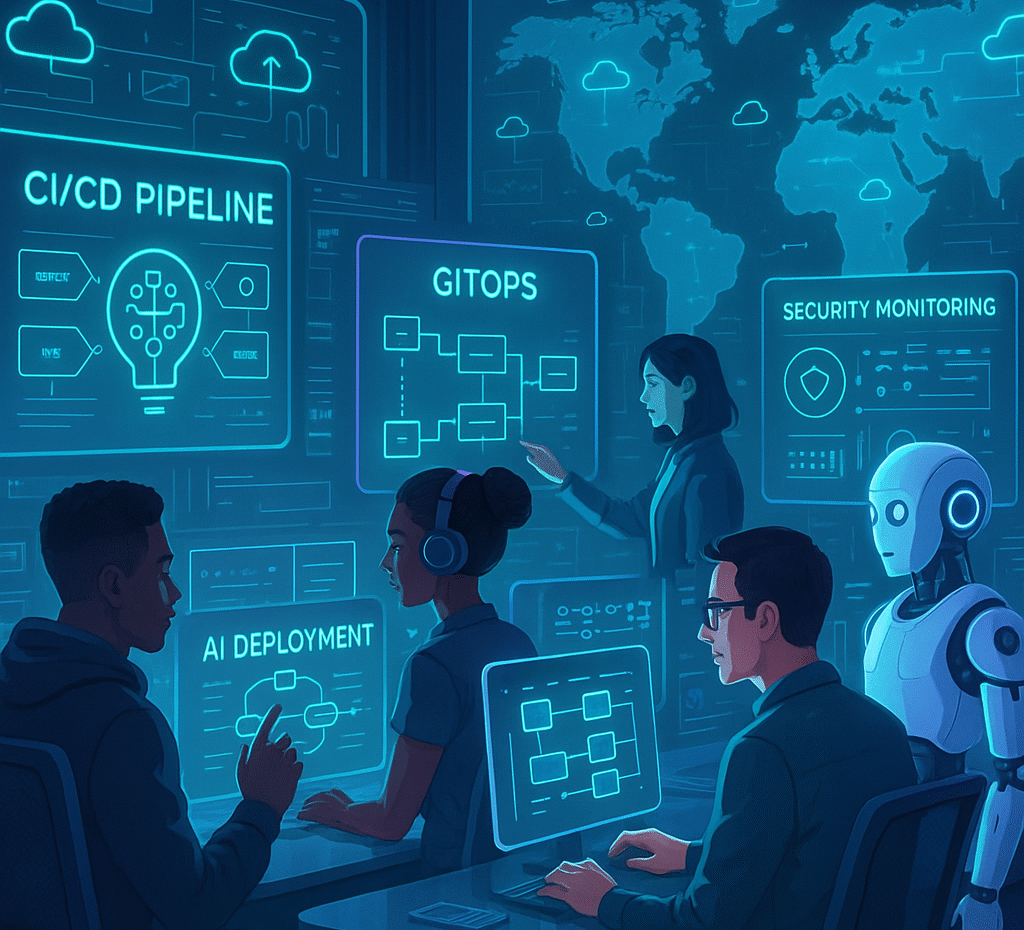- June 26, 2025
- by admin
DevOps in 2025: Streamlining Software Delivery Pipelines
Software delivery has always been a race against time faster releases, fewer bugs, and happier users. But in 2025, this race looks very different. DevOps has evolved from a set of practices into an intelligent, automated, and strategic pillar of modern software development.
With AI, GitOps, platform engineering, and security-first approaches taking center stage, DevOps in 2025 is not just about deploying faster it’s about building smarter pipelines that adapt, learn, and scale with business needs.
Let’s explore how DevOps has transformed and what the future holds for engineering teams.
🚀 The Evolution of DevOps
The term “DevOps” was coined over a decade ago to bridge the gap between development and operations. In its early days, it focused on:
Continuous Integration (CI)
Continuous Deployment (CD)
Automation of testing and builds
Infrastructure as Code (IaC)
Fast forward to 2025, and DevOps is now a highly strategic, AI-augmented discipline that spans everything from planning to monitoring across hybrid cloud, edge, and containerized environments.
🔧 What DevOps Looks Like in 2025
1. AI-Driven Pipelines Are the New Normal
AI and machine learning now play a core role in DevOps:
Predictive analytics forecast build failures or deployment risks.
Autonomous remediation tools fix issues without human intervention.
Test coverage, performance, and rollback decisions are algorithmically optimized.
AI doesn’t just speed things up it improves accuracy, consistency, and decision-making in real-time.
2. GitOps: Infrastructure Becomes Code, and Code Becomes Truth
By 2025, GitOps is no longer optional it’s foundational. Infrastructure, environments, secrets, and configurations are all version-controlled and declarative, with Git as the source of truth.
This means:
Environments can be spun up or rolled back instantly.
Consistency between staging and production is guaranteed.
Manual provisioning is practically extinct.
3. Platform Engineering Takes Center Stage
Enter the Internal Developer Platform (IDP) the curated interface between DevOps and developers.
DevOps teams now build platforms that offer self-service capabilities to developers.
Developers can deploy microservices, run tests, and monitor logs without needing deep Kubernetes or CI/CD expertise.
This shift frees DevOps teams to focus on scale, resilience, and automation.
In short, DevOps is becoming a platform provider, not a bottleneck.
4. Security is Baked In: DevSecOps Matures
Security is no longer “tacked on” at the end. In 2025, DevSecOps ensures:
Static and dynamic security testing is automated in CI/CD pipelines.
Container and dependency scanning is constant.
Compliance policies (like GDPR, HIPAA, SOC2) are enforced as code.
Security is now part of the pipeline, not an obstacle to it.
5. Observability Goes Beyond Monitoring
DevOps in 2025 relies on observability, not just uptime checks.
Teams track distributed traces, user journeys, and service dependencies.
AI detects anomalies and pinpoints root causes in seconds.
SLIs, SLOs, and error budgets are central to decision-making.
It’s not about alerting when something breaks it’s about knowing why and what to do next.
6. Low-Code and No-Code Integrations Are Growing
Just as LCNC is changing app development, it’s impacting DevOps too.
Business users can trigger builds, deploy workflows, and visualize releases via drag-and-drop dashboards.
Tools like GitHub Actions, Azure DevOps, and CircleCI are exposing no-code interfaces to orchestrate pipelines.
This shift is making DevOps accessible to more stakeholders, not just engineers.
🔁 Key Trends Shaping DevOps in 2025
| Trend | Impact |
|---|---|
| AI/ML in CI/CD | Smarter test prioritization, auto-scaling, and anomaly detection |
| GitOps Everywhere | Infrastructure defined, deployed, and audited through Git |
| Serverless and Edge | Pipelines optimized for low-latency, decentralized deployment targets |
| Zero Trust Architecture | DevOps integrated with fine-grained identity and policy controls |
| Policy-as-Code | Governance rules embedded directly into pipelines |
| Cross-Team Collaboration | Shared observability dashboards and incident response automation |
🧠 Skills and Culture: What DevOps Professionals Need Now
In 2025, a successful DevOps engineer is:
Fluent in Kubernetes, Terraform, GitOps workflows
Skilled in Python, Go, or Bash for automation
Comfortable with AI-assisted tooling
Trained in cybersecurity and compliance standards
Capable of cross-functional communication
Soft skills matter more than ever: collaboration, empathy, and strategic thinking are as valuable as technical chops.
💼 Business Benefits of Modern DevOps
Companies that embrace modern DevOps in 2025 are seeing:
Faster time to market with reliable delivery pipelines
Fewer production incidents due to early detection
Lower operational costs via automation and efficient tooling
Better team morale thanks to reduced firefighting and clearer workflows
DevOps is no longer about speed alone it’s about building systems that scale intelligently and securely.
🔮 What’s Next: DevOps Beyond 2025
As we look past 2025, several future-forward trends are emerging:
Cognitive DevOps: Systems that adapt based on past behavior, user intent, and business KPIs.
Fully autonomous pipelines: From code commit to production with zero human involvement.
Natural language deployment: “Deploy this version to staging” as a Slack message that triggers secure automation.
Digital twins for software: Simulate deployments before they go live, minimizing surprises.
The future is about resilience, autonomy, and intelligence, not just velocity.
✨ Final Thoughts
DevOps in 2025 is no longer a niche practice it’s a business imperative. The tools are smarter. The pipelines are leaner. The expectations are higher. And the dev–ops–sec–biz boundaries are finally disappearing.
If your team is still treating DevOps as “just tooling,” it’s time to rethink. The future belongs to those who treat DevOps as strategy a cultural, technical, and organizational shift that puts software delivery at the heart of growth.

